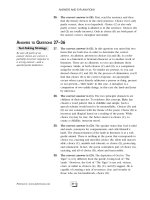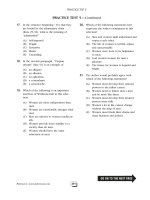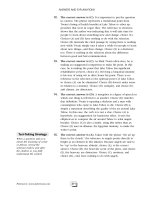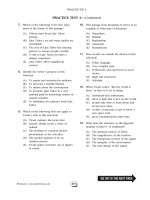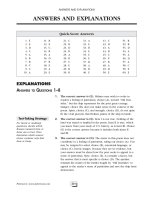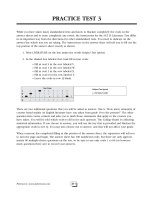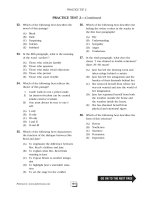SAT II success literature Episode 2 Part 8 pps
Bạn đang xem bản rút gọn của tài liệu. Xem và tải ngay bản đầy đủ của tài liệu tại đây (68.18 KB, 8 trang )
26. The correct answer is (B). First, read the sentence and then
find the literary devices in the cited sentence. Choice (A) is only
partly correct; there is no hyperbole. Choice (C) is also only
partly correct; nothing is alluded to in this sentence. Choices (D)
and (E) are totally incorrect. Only in choice (B) are both parts of
the answer correct, metaphor and simile.
ANSWERS TO QUESTIONS 27–36
Test-Taking Strategy
Be sure all parts of an
answer choice are correct. A
partially incorrect response is
a wrong answer—and a
quarter-point deduction.
27. The correct answer is (E). In this question you must find two
items that are both true in order to determine the correct
answer. An allusion, present in choices (A) and (B), is a refer-
ence to a historical or fictional character or to another work of
literature. There are no allusions, so you can eliminate those
responses. Simile, in both choices (C) and (D), is a comparison
using the words like or as. No similes are present, so you can
discard choices (C) and (D). By the process of elimination, you’ll
find that choice (E) is the correct response. An apostrophe
occurs when a poet directly addresses a person or thing, present
or not present—“little lamb” in this case. A metaphor is a
comparison of two unlike things, in this case the lamb and Jesus
by inference.
28. The correct answer is (C). The two principle characters are
children of their species. To reinforce this concept, Blake has
chosen a word pattern that is childlike and simple. Such a
speech scheme would tend to be monosyllabic. Choices (D) and
(E) are not consistent with the theme of the poem. Choice (B) is
incorrect and illogical based on a reading of the poem. While
choice (A) may be true, the better answer is choice (C), to
create a childlike, innocent mood.
29. The correct answer is (D). The speaker states that God is mild
and meek, synonyms for compassionate, and calls Himself a
lamb. The characterization of the lamb in literature is as a soft,
gentle animal. There is nothing in the poem that corresponds to
choice (A), exacting and merciful; choice (B), silent and inacces-
sible; choice (C), amiable and tolerant; or choice (E), protecting
and omniscient. In fact, the poem contradicts part of choice (A),
exacting, and all of choice (B), silent and inaccessible.
30. The correct answer is (D). The depiction of God in “The
Tiger” is very different from the gentle, loving God of “The
Lamb.” However, the God of “The Tiger” is not evil, vicious,
cruel, or unfair as choices (A), (B), (C), and (E) suggest. He is
capable of creating a mix of reverence, fear, and wonder in
those who see his handiwork, choice (D).
ANSWERS AND EXPLANATIONS
311Peterson’s: www.petersons.com
31. The correct answer is (E). All of the Roman numeral items are
correct. Blake dramatizes the fierce cruelty of the tiger in this
stanza and also seeks to arouse a feeling of wonder in the
reader. Only choice (E) contains all three items and is, therefore,
the correct answer.
32. The correct answer is (C). This is a good question for the
educated-guessing technique. Nothing about battles appears in
the poem, so you can exclude choice (A). The question asks
about where the tiger was created, not where he lives, so
discard choice (B). There is no allusion to Roman mythology, so
choice (E) can be ruled out. Choice (D) can also be discarded
because there is no mention of bars, punishment, or incarcera-
tion.
33. The correct answer is (D). Blake creates four characters, the
lamb, the tiger, and two speakers. You can reasonably assume
that the speakers are the same. These speakers draw parallels
between the speakers’ relationships with the animals and with
God. The answer most consistent with this is choice (D), all
beings are one with God. Choices (A) and (E) do not mention
the deity at all. Nowhere in either poem is there a suggestion
that animals were created for humanity’s use, choice (B). Choice
(C) is too literal a reading of the poems.
Review Strategy
See A Quick Review of
Literary Terms, chapter 4.
34. The correct answer is (B). Scan both poems to check which
of the three options is present. You will notice immediately that
there is extensive repetition in both poems, so item I is correct.
Both poems begin by directly addressing an animal, apostrophe,
so item II is true. Blake does not give human characteristics to
either the lamb or the tiger, so there is no personification,
eliminating item III. Therefore, the correct answer is the only
choice that includes both items I and II, choice (B).
35. The correct answer is (C). The question is most easily
answered through the process of elimination. Choice (A) is a
distracter; that subject is never discussed. Choice (B) applies to
“The Tiger” but not to the subject matter of “The Lamb,” so it
can be discarded. Choice (E) can be ruled out for the same
reason. While one could infer that the poems explore what
ordinary people believe, choice (D), the inference is too broad
when you also consider choice (C). Choice (C) touches on the
religious aspects of the poem and is the more accurate response
to the question.
SAT II SUCCESS: LITERATURE
312 Peterson’s SAT II Success: Literature
Test-Taking Strategy
Highlight—circle, bracket,
underline—the key words in
the questions so you will be
sure you know what you are
looking for as you review the
answer choices.
36. The correct answer is (A). This question asks you to combine
the themes of both poems into a logical statement of the poet’s
beliefs. Eliminate choices (C) and (D) because they do not
combine elements from both poems. Discard choice (E) because
it does not answer the question, which asks about Blake’s view
of the world. Look at choice (B). Is Blake really saying that the
tiger is evil? Or is he saying that it is a powerful, terrifying
creature of God? Yes to the latter question, so choice (B) is not
a good answer. The correct response, choice (A), reconciles the
symbolic elements of the lamb and the tiger and the writer’s
strong religious feeling and provides an interpretation that is
logical and consistent with both poems.
ANSWERS TO QUESTIONS 37–42
Review Strategy
See A Quick Review of
Literary Terms, chapter 4.
37. The correct answer is (B). Choice (A) is incorrect. An allusion
is a reference to a well-known work or famous figure. A conceit,
choice (C), an elaborate figure of speech in which two seem-
ingly dissimilar things are compared, does not apply. You may
be tempted by choice (D), personification, because it does
appear that the writer seeks to personify the wind, but the key
word in this question is calls, making choice (B) the correct
answer. Choice (E), metaphor, a comparison, does not apply.
38. The correct answer is (C). In the kind of heat described in
this poem, one might feel all of the choices listed, but the word
that best captures the author’s intent is choice (C), oppression.
The word thick is a good clue. The heat is so oppressive—
weighing heavily—that fruit cannot drop.
39. The correct answer is (A). Choice (B), elegy, is ruled out
because the poem is not about death or mortality. Choice (C),
ode, is eliminated also because this is not a long poem in praise
of someone or something. Sonnet, choice (D), is easily ruled out
from your knowledge of poetic genres; just count the lines—
thirteen. Choice (E) can be eliminated also because the writer is
not telling a story. This poem is clearly a lyric, choice (A), a
short, personal kind of poem expressing the feelings of one
speaker.
ANSWERS AND EXPLANATIONS
313Peterson’s: www.petersons.com
Test-Taking Strategy
For not/except questions, ask
yourself if the answer is
correct in the context of the
selection. If it is, cross it off
and go on to the next
answer.
40. The correct answer is (D). Review the author’s choice of
words. They are simple and precise, which rules in choice (A).
The poem has many excellent physical textures—“rend,” “cut,”
“tatters,” “thick,” “blunts,” to name a few—ruling in choice (B).
Choice (C), vivid, emotional images, is ruled in for the same
reasons. Read the lines for rhythm. There is nothing traditional,
choice (D), about them. Choice (E) is evident in stanzas 1 and 3.
Choice (D), then, is the exception and thus the correct answer.
41. The correct answer is (B). Item I is incorrect. The key word
here is retards. The heat does not simply slow down movement;
it prevents it. In addition, there is no mention or implication of
growth in the poem. Item II is true. The wind cannot “rend” or
“cut” something vaporous. Item III is wrong. The key word here
is dissipated. The author does not instruct the wind to make the
heat disappear; the poet tells the wind to “rend” it. Because only
item II is correct, choice (B) is the right answer.
42. The correct answer is (E). Aural means hearing, and such
images are not present in this poem, ruling out choice (A). The
visual images, choice (B), are vivid; “wind,” “rend,” and “fruit”
are readily identifiable. Tactile images, choice (C), are also in
evidence: “presses,” “blunts,” “cuts,” and so forth. Choice (D),
which includes the sense of taste, is a distracter. Although fruit
is tasty, it is not used in this poem in a way that appeals to the
sense of taste. Many images in this poem appeal to both sense of
vision and of touch, making choice (E) the right answer.
ANSWERS TO QUESTIONS 43–52
43. The correct answer is (D). Choice (A) can be eliminated,
because although the device of a dialogue between Gout and
Franklin may be entertaining, the subject matter and useful
information about leading a healthy life are neither silly nor
frivolous. The remaining possibilities seem reasonable. There is
scientific information, choice (B), included, and it is objective,
choice (C). The piece is structured as dialogue, choice (E).
However, only choice (D) includes both elements of the
tone—the humor and the medical information given.
SAT II SUCCESS: LITERATURE
314 Peterson’s SAT II Success: Literature
44. The correct answer is (A). Each of the choices has some
element of correctness. There are comments about health in
choice (B). Dialogue occurs, although not for a morality play,
choice (C), so it can be eliminated. Franklin does mention the
pain of the gout attack, choice (D). Some discussion about
exercise takes place, choice (E). However, to be the best
answer, the entire choice must be correct and, because the
question asks for the theme, must apply to the entire passage.
Only choice (A) does both.
Test-Taking Strategy
Be careful of distracters.
They have something to do
with the selection and on a
quick reading, you may
choose one. Go back to the
selection and check your
answer.
45. The correct answer is (D). On the surface, all of these choices
seem correct because each is mentioned in the selection.
However, choices (A), (B), (C), and (E) are specific details of
Franklin’s point that reasonable and responsible behavior cures
the gout, choice (D).
Review Strategy
See A Quick Review of
Literary Terms, chapter 4.
46. The correct answer is (A). A metaphor, choice (B), is a figure
of speech in which one thing is spoken of as though it were
something else. Choice (C), a conceit, is an elaborate figure of
speech comparing two unlike things. Choice (D), onomatopoeia,
is the use of a word whose sounds imitates the sound of the
thing being named. Another type of comparison, a simile, choice
(E), is a figure of speech that compares two unlike things by
using words such as like or as. None of these applies to the
selection. Personification, (A), the giving of human characteris-
tics to nonhuman things, allows the disease to speak.
47. The correct answer is (A). Choice (C), disgusted; choice (D),
conciliatory; and choice (E), perfunctory do not express the tone
of any of Gout’s comments. The issue in determining the correct
answer is between choice (A), stern, and choice (B), didactic.
Gout is not lecturing Franklin about health facts, choice (B), but
pointing out very firmly his failings. Therefore, choice (A) is
correct.
48. The correct answer is (D). Any good writer will have clear
organization, choice (A), so it is not the response necessarily
most specific to this piece. Choices (C) and (E) are terms more
accurate for describing tone. Choice (B) could only be chosen
by an inaccurate reading; dialogue is not so unusual a literary
device. The dialogue is logically developed, making choice (D)
correct. Remember that developmental order, which arranges
information so that one piece follows another logically, is a
method of prose organization.
ANSWERS AND EXPLANATIONS
315Peterson’s: www.petersons.com
49. The correct answer is (B). The key here is to notice that the
word interests is plural. Franklin does enjoy being with friends,
choice (E), but that is only one interest, so you can rule out this
answer immediately. Information is unavailable in the excerpt to
support choice (A). Eliminate choice (C) because there is no
information to support the statement that his work is secondary
to his pleasure. Knowing Franklin as a historical figure would
indicate that this is probably untrue. He may like walking in the
gardens, choice (D); he says so but does not act as if he does, so
discard this answer. That leaves choice (B). It best characterizes
what we know about Franklin from the selection—he enjoys
those things that do not require him to do anything more than sit.
50. The correct answer is (B). Choice (A) is incorrect because
Gout is not misinterpreting Franklin the character’s actions; in
fact, Franklin agrees with Gout. The topic is serious—Franklin
the character agrees with Gout—so Franklin the author’s
purpose is more than to write some lighthearted prose, choice
(E). Choice (C) is inaccurate because the motives are clearly
developed. The dialogue is developed in such a way as to make
Gout’s argument more persuasive, thus eliminating choice (D) as
illogical. The use of dialogue permits Franklin to focus on Gout’s
comments and easily refute Franklin the character’s defense.
51. The correct answer is (C). Franklin will not answer because
he knows he did not follow his own advice. At this point in the
dialogue he is not arguing with Gout, choice (B), nor is there
any sign that he is tired of her, choice (A). (The character of
Gout is female in the dialogue.) While he may not be arguing
with Gout, he has not suddenly become charming either, choice
(E). Franklin’s statement shows evasiveness more than either
nervousness or defeat, choice (D).
52. The correct answer is (A). This is a very personal poem and,
therefore, fits the definition of a lyric, choice (A). It does not
have the format of a sonnet—14 lines, choice (B). It is neither
long nor full of praise for a person, choice (C), and it does not
tell a story, choice (D). While it is about death, it is not as
formal as an elegy, choice (E).
SAT II SUCCESS: LITERATURE
316 Peterson’s SAT II Success: Literature
ANSWERS TO QUESTIONS 53–60
53. The correct answer is (B). Choice (E) is simply incorrect in
the context of the poem. Choice (C) is too broad; this is a very
personal poem. Choices (A) and (D) are illogical because they
are not supported by the poem. Of these answers, choice (B)
best characterizes the theme, or message, of this poem.
Test-Taking Strategy
Go back to the selection.
Don’t rely on what you think
it says.
54. The correct answer is (D). This is a straightforward compre-
hension question. Choice (A), God, and choice (E), familial love,
are too broad. Choice (B), the glory of nature, and choice (C),
spring, are irrelevant to the poem. Absolute proof is found in
lines 17 and 18.
55. The correct answer is (E). Some of each of the answers may
seem true, but remember to focus on the fourth stanza. The first
three stanzas focus on the beauty of nature, choice (B), and also
establish the mood, choice (C). Choice (D) is a distracter, and
choice (A) is irrelevant to the fourth stanza. Only choice (E)
describes the purpose of the transition in focus that occurs with
the fourth stanza.
56. The correct answer is (E). While this question seems to be
about a detail, it is also about the theme of the poem. The
speaker is saddened by his daughter’s death, and the falling
snow reminds him of her grave. Only choice (E) reflects this
theme. Choice (A) is contrary to the facts. Choices (B) and (C)
are not relevant. The setting, choice (D), is established earlier in
the poem, leaving choice (E) as the correct response.
57. The correct answer is (C). The best answer is the choice that
best defines the tone and that is the most complete. Choice (A) is
easily ruled out because it is the opposite of what the poem
evokes. Choice (B) is present in the poem but is not the whole
story. Part of choices (D) and (E) capture the tone, but the second
half of each does not fit. Choice (D) is eliminated because the tone
is not angry. Choice (E) is eliminated because it says nothing of the
bit of hope in the poem, expressed by such lines as “healing and
hiding/That scar.” Only choice (C) offers the most complete de-
scription of the overall tone—sadness and hope.
ANSWERS AND EXPLANATIONS
317Peterson’s: www.petersons.com
58. The correct answer is (D). The answer hinges on the not in the
question. It is snowing, so logically it is winter, and in addition,
the poem is called “the first snow,” which makes it more likely
that it’s winter, choices (A) and (E). Lines 1 and 2 imply that the
snow began the evening before, and line 10 reinforces this by
mentioning the rooster crowing, so choice (B) is true. Although a
funeral had taken place, choice (D), it is over, the grave is cov-
ered, and snow has gathered around the tombstone, choice (C).
Test-Taking Strategy
In a question asking for the
meaning of a word or
phrase, substitute the choices
in the sentence and read the
line for sense. Read the lines
around the cited line as well
for context.
59. The correct answer is (B). Line 2 provides a clue with the word
night. Choice (C), first light, and choice (E), autumn, do not make
sense with “night.” Choice (A), increasing cold, and choice (E),
wind, might be correct, but in context, the time of day, choice
(B), dusk, makes better sense than a climate characteristic.
60. The correct choice is (D). Don’t rely on your memory of what
you think you read. Check the text, and you will find that the
correct response is choice (D), “that cloud.” Choice (A) is too
early in the poem to refer to the All-Father, who is not intro-
duced until the sixth stanza. Choice (B), “the mound in sweet
Auburn,” refers to the child’s grave. Choice (C), “the leaden
sky,” might appear to be a possibility, but upon reading the
cited line and those around it, you will find that the image refers
either literally to the sky or metaphorically to the father’s frame
of mind when the child was buried. Choice (E), “the snow that
husheth all,” is a work of the All-Father. Choice (D), “the cloud,”
refers to the beneficence of the All-Father who brought healing
and distance through patience to the sorrowing father.
SAT II SUCCESS: LITERATURE
318 Peterson’s SAT II Success: Literature



